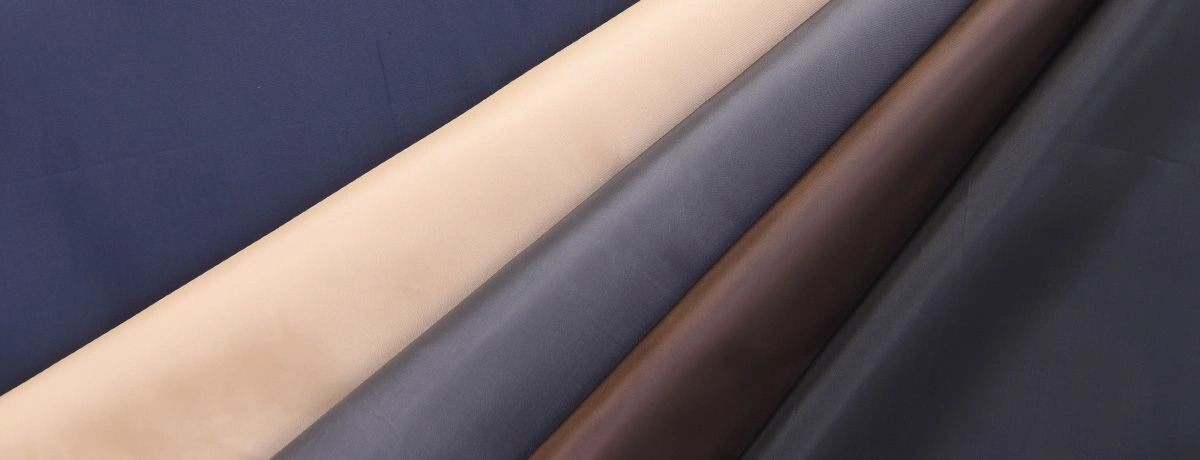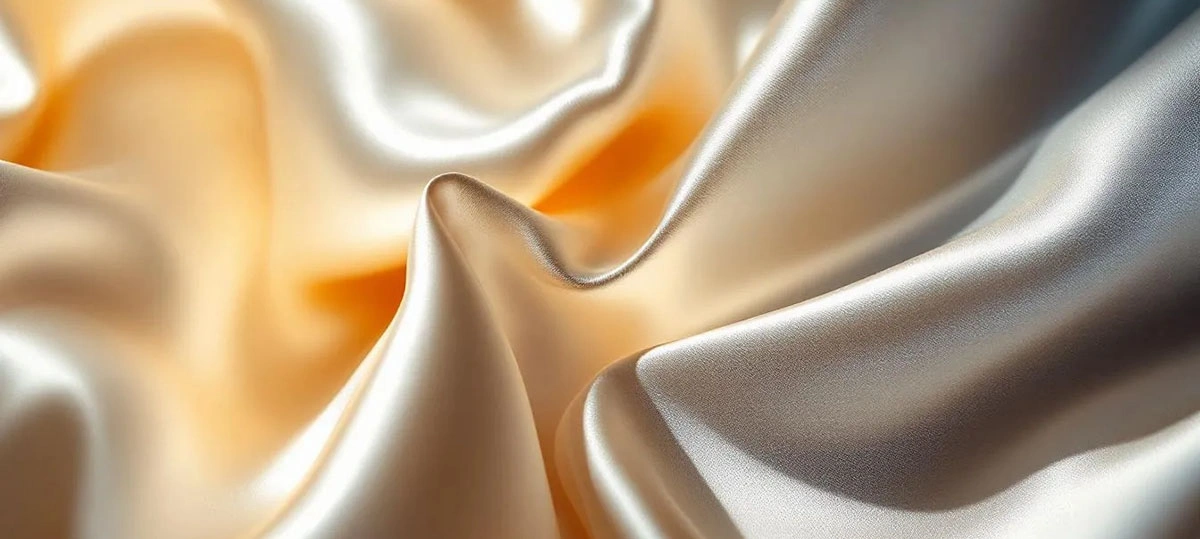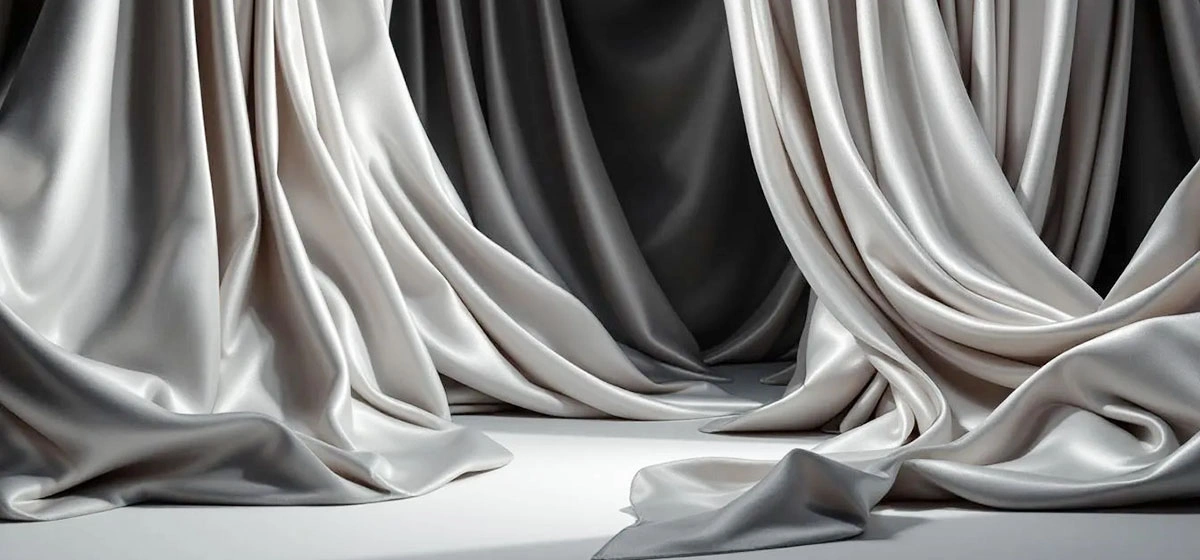Taffeta Fabric Explained: Types, Uses, and Benefits

Taffeta is a crisp fabric known for its smooth texture and shiny finish. Made from materials like silk or polyester, it’s used in fashion and home decor. Read on to learn about taffeta’s types, uses, and benefits.
Key Takeaways
-
Taffeta fabric is characterized by its lightweight, crisp, and durable nature, making it ideal for structured garments and elegant home decor.
-
Several types of taffeta, including silk and polyester variations, provide diverse options for various applications, from high-end fashion to everyday use.
-
The environmental impact of taffeta varies by type, with silk taffeta being more sustainable than synthetic polyester, which poses greater pollution and waste challenges.
Understanding Taffeta Fabric

Taffeta fabric is renowned for its crisp, smooth, and lightweight properties, making it synonymous with luxury. This exquisite fabric can be crafted from a variety of materials, including:
-
Silk
-
Rayon
-
Polyester Each material contributes to its unique texture and feel. One of the defining characteristics of taffeta is its ability to hold shapes, lending itself perfectly to structured garments that demand a touch of elegance.
Historically, taffeta has deep roots, tracing back to Ancient Persia where it was initially developed. Over the centuries, it has evolved significantly, maintaining its status as a preferred fabric in high-end fashion and home decor. Its glossy finish not only enhances its visual appeal but also adds a layer of sophistication to any garment or item it is used in.
Beyond fashion, taffeta’s versatility extends to practical uses in event decor and specialty items, showcasing its durability and aesthetic charm. Despite its lightweight nature, taffeta has a firm feel, making it a substantial choice for various applications. Whether used for elegant evening gowns or durable home furnishings, taffeta fabric continues to be highly valued across different fields.
Key Characteristics of Taffeta
Taffeta fabric is celebrated for its lightweight yet highly durable nature, making it an ideal choice for structured garments that require both form and function. Key characteristics include:
-
Weight can vary from very lightweight to medium weight, allowing for diverse applications.
-
Unique crisp texture that sets it apart from many other lightweight textiles.
-
Exceptional ability to hold its shape well.
One of the most striking features of taffeta is its ability to produce an iridescent effect when woven with different colors. This visual appeal is further enhanced by the fabric’s excellent dye-holding properties, allowing for vibrant and long-lasting colors. Taffeta can be dyed either before weaving (yarn-dyed) or after (piece dyed taffeta), each method influencing its texture and appearance in distinct ways.
The stiff nature of taffeta makes it particularly suitable for garments that require volume and form, such as evening gowns and formal wear. Its ability to maintain structure without compromising on aesthetics has made it a favorite among designers and fashion enthusiasts alike. Whether it’s the vibrant hues or the crisp texture, taffeta fabric offers a unique combination of beauty and practicality.
Types of Taffeta Fabric
Taffeta fabric comes in several distinct types, each offering its own unique qualities and applications. Among the most popular are:
-
Silk taffeta
-
Polyester taffeta Additionally, there are specialized varieties like:
-
Shot silk taffeta These varieties add even more diversity to this fabric’s repertoire.
Silk taffeta is known for its luxurious feel and high cost, making it a staple in high-end fashion. Polyester taffeta, on the other hand, offers a more cost-effective alternative while retaining durability and versatility. There are also other fascinating varieties like moire taffeta, which features a distinctive wavy pattern, and shot silk taffeta, renowned for its iridescent effect.
These different types of taffeta ensure that there is a suitable option for every purpose, whether it be for creating elegant evening wear, durable home furnishings, or specialty items. Understanding the unique qualities of each variety can help in selecting the perfect taffeta fabric for any project.
Silk Taffeta
Silk taffeta is a luxurious fabric made from natural fibers, known for its elegant appearance and high cost. Despite being lightweight, it is incredibly durable and possesses a distinctive crisp texture that holds its shape well. This makes it an ideal choice for high-end garments such as evening gowns and wedding dresses, where elegance and structure are paramount.
The iridescent effect of silk taffeta is one of its most captivating features, achieved by weaving different colored yarns together. This visual appeal, combined with its smooth and lightweight nature, makes it a favorite among designers for creating voluminous skirts, corsets, and other formal wear. The fabric’s ability to hold vibrant colors further enhances its luxurious feel and appearance, adding a touch of light elegance.
Silk taffeta’s elegance is unmatched, making it a go-to choice for those special occasions that demand a touch of sophistication. Its high cost is often justified by its superior quality and the dramatic effect it brings to any garment. Whether for evening gowns or intricate corsets, silk taffeta remains a symbol of luxury and refinement.
Polyester Taffeta
Polyester taffeta fabric offers a more cost-effective alternative to its silk counterpart, without compromising on durability. The production of polyester taffeta is more widespread, contributing to its affordability and making it accessible for everyday clothing and formal wear alike. Its versatility and resilience make it a popular choice for prom dresses and other garments that require both elegance and longevity.
Despite being synthetic, polyester taffeta retains many of the desirable qualities of silk taffeta, including a smooth texture and the ability to hold vibrant colors. This makes it an excellent option for those looking to achieve a luxurious look without the high cost associated with natural polyester fibers.
The widespread availability and cost-effectiveness of printed polyester taffeta make it a staple in the textile industry.
Other Varieties
Among the diverse collection of taffeta fabrics, moire taffeta stands out with its unique rippling watermark pattern, adding a touch of sophistication to any garment or decor. Shot silk taffeta, another specialty variety, is known for its iridescent appearance, achieved by weaving different colored threads together, resulting in a mesmerizing play of colors. These specialty taffetas offer unique visual and tactile experiences that set them apart from standard varieties.
Fil Coupé taffeta is another fascinating variety, featuring a jacquard design that incorporates shiny, blended yarns for a dramatic effect. These specialty pompadour taffeta, with their distinctive patterns and effects, provide designers with creative options for crafting unique and eye-catching garments. The diverse types of taffeta ensure that there is always a perfect fabric for every creative vision.
Uses of Taffeta Fabric

Taffeta fabric is widely recognized for its versatility and is used in various fields, most notably in fashion and home decor. Its elegant appearance and structured feel make it a preferred choice for evening gowns, skirts, jackets, and accessories. In addition to high-end fashion, taffeta’s durability and aesthetic appeal make it suitable for home decor applications like curtains and upholstery.
Beyond fashion and home decor, taffeta is also utilized in costume design, lining for bags, and even insulation materials. Its lightweight yet durable nature makes it an excellent choice for a wide range of non-clothing applications, including clothing fabric.
Whether used for creating elegant garments or enhancing the aesthetic appeal of indoor spaces, taffeta fabric continues to be highly valued for its versatility and beauty.
Fashion Industry
In the fashion industry, taffeta fabric is often used for high-end garments, particularly evening gowns and bridal dresses, thanks to its luxurious feel and structured appearance. The crisp texture and sheen of taffeta make it ideal for creating sophisticated evening wear, adding an element of glamour and elegance to any outfit. The distinctive rustling sound it produces as the wearer moves further enhances its appeal for formal occasions.
Taffeta is frequently chosen for creating structured garments like skirts and jackets, where its ability to hold shape is highly valued. Designers often use taffeta to shop for accessories as well, taking advantage of its vibrant colors and elegant texture to create eye-catching pieces.
Whether for special occasions or high-fashion collections, taffeta remains a go-to fabric for adding sophistication and flair to any dress garment.
Home Decor
In home decor, taffeta’s notable durability and aesthetic appeal make it a popular choice for creating elegant window treatments, upholstery, and other decorative items. The fabric’s attractive appearance and ability to hold vibrant colors enhance the visual appeal of indoor spaces, making it a favorite among interior designers.
Taffeta is widely used for making curtains, adding a touch of elegance to any room with its smooth texture and sheen. Its durability ensures that these decorative items not only look beautiful but also stand the test of time. Whether used for sophisticated window treatments or luxurious upholstery, taffeta continues to be a preferred choice in home decor.
Other Applications
In addition to its use in fashion and home decor, taffeta fabric finds applications in various other fields. Its lightweight yet structured nature makes it suitable for costume design and theatrical props, where durability and visual appeal are essential. Taffeta is also used as a lining material for bags, providing a smooth and durable finish that enhances the overall quality of the product.
The versatility of taffeta extends to insulation materials as well, where its lightweight and durable properties prove beneficial. Whether used for practical purposes or creative endeavors, taffeta’s unique qualities make it a valuable fabric in many different applications. From costumes to bag linings, taffeta continues to be a versatile and reliable choice.
Environmental Impact of Taffeta
When considering the environmental impact of taffeta, it’s essential to distinguish between silk taffeta and synthetic varieties like polyester. Silk taffeta production is generally more sustainable, utilizing a renewable source and being biodegradable. However, the harvesting of silk can require substantial water resources, although some producers implement eco-friendly practices to mitigate this.
On the other hand, synthetic taffeta, such as polyester, significantly contributes to environmental pollution due to its petroleum origins. The production process of synthetic fibers increases carbon emissions and poses long-term waste challenges, as these materials can take centuries to decompose in landfills. The larger scale of synthetic fiber production exacerbates these environmental concerns.
While silk taffeta offers a smaller environmental footprint, the widespread use and production of synthetic taffeta highlight the need for more sustainable practices in the textile industry. As consumers and producers become more environmentally conscious, the push for eco-friendly alternatives and sustainable practices in taffeta production will hopefully continue to grow.
Caring for Taffeta Fabric
Caring for taffeta fabric requires special attention to maintain its quality and appearance. Spot cleaning is often recommended for minor stains, using a mild detergent on a soft cloth to gently remove marks without damaging the fabric. For valuable taffeta garments, professional dry cleaning is advisable to ensure they retain their luxurious look and feel.
When it comes to storage, minimizing wrinkling is crucial. Here are some tips for storing and caring for taffeta:
-
Store taffeta on padded hangers in a dry, ventilated space to prevent creases and maintain its shape.
-
If folding is necessary, use acid-free tissue paper to help prevent permanent creasing.
-
For minor wrinkles, use a handheld steamer.
-
If ironing is needed, use the lowest setting and a pressing cloth to avoid damage.
Baking soda can also be used as a gentle cleaning solution by mixing it with water to treat stains without harsh chemicals. These care techniques ensure that taffeta fabric remains beautiful and functional for years to come, preserving its elegance and durability.
Where Taffeta Fabric Is Produced
Taffeta fabric production spans across various regions, with India and China being the largest producers. These countries are known for their extensive textile industries, which produce taffeta in large volumes suitable for both local and international markets. The cost-effectiveness of taffeta from these regions makes it accessible for a wide range of applications.
Western countries, particularly France and Italy, are famed for their high-quality taffeta production. These regions focus on crafting premium taffeta fabrics, often used in high-end fashion and luxury home decor.
Additionally, Russia has emerged as a notable exporter of taffeta fabric, contributing to the global supply. The diverse production regions ensure a steady supply of taffeta, catering to various quality and price points.
Summary
Taffeta fabric, with its rich history and versatile applications, remains a beloved choice in both fashion and home decor. Its unique characteristics, including a crisp texture, vibrant colors, and ability to hold shapes, make it ideal for creating elegant garments and sophisticated home furnishings. The different types of taffeta, from luxurious silk to cost-effective polyester, provide options for various needs and preferences.
Understanding the environmental impact and proper care of taffeta ensures that this beautiful fabric can be enjoyed sustainably and maintained in top condition. Whether used for high-end fashion, practical home decor, or creative projects, taffeta continues to captivate with its timeless appeal. Embrace the elegance and versatility of taffeta fabric, and let it inspire your next project.
Frequently Asked Questions
What are the main types of taffeta fabric?
The main types of taffeta fabric are silk taffeta, polyester taffeta, and specialty varieties such as moire and shot silk taffeta. Each type offers unique qualities suitable for different applications.
How is taffeta fabric used in the fashion industry?
Taffeta fabric is predominantly utilized in the fashion industry for creating high-end garments like evening gowns and wedding dresses, owing to its elegant appearance and structured feel. This makes it a preferred choice for designers aiming to convey sophistication.
What makes taffeta fabric suitable for home decor?
Taffeta fabric is suitable for home decor due to its durability and aesthetic appeal, making it an excellent choice for items such as curtains, linings, and upholstery.
What are the environmental impacts of taffeta fabric?
Taffeta fabric can have significant environmental impacts, particularly with synthetic varieties like polyester, which contribute to pollution and waste. In contrast, silk taffeta is more sustainable as it is biodegradable and renewable.
How should taffeta fabric be cared for?
To care for taffeta fabric, spot clean with mild detergent, use professional dry cleaning for valuable items, and store it on padded hangers. When ironing or steaming, always use a low setting along with a pressing cloth to prevent damage.
Contact MH
MH offers taffeta fabrics. Please contact us for more details or inquiries. We're here to help!
Resources Page
- Taffeta Table Linens: Your Complete Wholesale Guide
- Taffeta Plaid Fabric: A Complete Guide for Manufacturers
- Taffeta Fabric White: Essential Guide for Professional Applications
- Taffeta vs Polyester Tablecloth: Which Fabric Wins for Wholesale?
- Taffeta Embroidered Fabric: Premium Solutions for Manufacturing
- Taffeta Fabric Price Guide: What Wholesale Buyers Need to Know
- Waterproof Taffeta: The Complete Wholesale Guide
- Cotton Taffeta: The Versatile Fabric for Modern Manufacturing
- How to Choose the Perfect Black Silk Taffeta Fabric
- Teal Taffeta: The Complete Guide for Garment Manufacturers
- Blue Silk Taffeta Fabric: The Premium Choice for Wholesale Buyers
- Quilted Taffeta Fabric: The Premium Choice for Wholesale Applications
- Royal Blue Taffeta: The Ultimate Fabric for Premium Applications
- Navy Taffeta Fabric: The Premium Choice for Professional Applications
- Understanding Tissue Taffeta Fabric: The Premium Lightweight Material
- Your Complete Guide to Sewing with Taffeta
- Ivory Taffeta: A Guide for Manufacturers
- Red Taffeta Fabric: A Premium Choice for Garment Manufacturing
- Purple Taffeta: The Premium Choice for Professional Manufacturing
- Orange Taffeta: The Complete Guide for Wholesale Buyers


